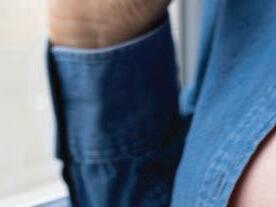
5 minute read
Libraries keep closing for meth
Should they solve the problem?
toxic contamination left behind by patrons smoking drugs in the bathrooms.
In an extraordinary domino e ect, four libraries, some of the last public spaces welcome to everyone, closed. Some libraries hoped the public would see the closures as a wake-up call, opening eyes to what they deal with every day, according to emails of library directors obtained by e tor worried about the health of his two-person cleaning team repeatedly sent into the bathroom after reports of putrid smoke. Englewood Public Library, also plagued by meth clouds, discovered in mid-January that its bathrooms were contaminated. Littleton, “in the interest of being proactive,” was next, also nding levels of meth residue exceeding the state health department’s legal limit. popular branches. e meth closures in Colorado made national news, from People magazine to e New York Times. Public reaction vacillated between accusing the libraries of causing hysteria to wondering how far society has sunk.
Of the four libraries that closed, only Boulder has reopened, though the bathrooms are sealed o by a temporary wall and plastic until they are cleaned by a professional meth lab remediation company. e Boulder library was closed for three weeks. Englewood has been shut down for nearly a month, and Littleton for two and a half weeks. Arvada closed more than a week ago.
Boulder library director David Farnan doesn’t regret closing the doors, even though he said he learned from local and state health o cials within a few days of the closure that no one’s health was ever at risk.
After 14 incidences of drug use in about three weeks, he’d already had a policy in place to shut down the bathrooms and not let anyone — even the cleaning crew — enter if there were fumes in the air.
But just because no one’s health was at risk, that doesn’t mean it’s acceptable, he said.
“We have to do everything we can to prevent this from ever happening again,” Farnan said. “We can’t have a public library and have meth use going on in the bathroom. at’s just a no-brainer.”
So the library will again nd a way to adapt. e plan is to keep the restrooms closed to the public, except for children accompanied by their parents and people who have a medical condition. It’s the best way Farnan sees to preserve the library’s mission to serve all, whether they are parents and kids coming to story time, seniors using the internet or people who sleep outside.
“It’s one of the few places where anyone can go, everyone is treated with decency and you don’t have to buy anything,” he said. “ at’s rare. e value of having a public place is extraordinary.”
Colorado’s standard for meth contamination isn’t based on public settings
Here is how many reports of patrons a ected by meth contamination the libraries received: Zero.
Two Boulder library employees reported feeling “dizzy” after walking into a smoke- lled room in late November and were checked out by paramedics, but both had normal vital signs and no evident symptoms of narcotics exposure.
And for public health experts who have studied meth exposure, that doesn’t come as a surprise.
“I think the health risks when we nd that amount — by design — are negligible,” said Mike Van Dyke, whose research on meth exposure helped establish the state’s decontamination procedures and sampling requirements.


In Colorado, a space is considered contaminated if meth residue is detected at levels above 0.5 micrograms per 15.5 square inches. e threshold is based on a child being exposed for a long period inside a home.
“It was really established for the worst-case exposure, which would be a toddler living 24 hours a day, seven days a week, in a contaminated home crawling over carpets, putting their hands in their mouth, doing all of those things,” said Van Dyke, now a professor at Colorado School of Public Health.

But public restrooms are a far different setting than one’s living room.
Nonporous tiled oors and countertops make it easy to wipe o meth residue, which is very water soluble. People don’t spend much time in a public restroom and typically try to avoid touching surfaces to limit the spread of germs.
“So let’s say you touch a surface, you wash your hands before you leave. You’ve generally washed the vast majority of meth o of yourself even if you were exposed,” he said.
“ ere’s really low opportunity for exposure.” resholds requiring a space to decontaminate detected meth residue vary per state, with some states having much higher limits than Colorado. In Wyoming, for example, the threshold requiring decontamination is set at 1.5 micrograms, according to a 2019 review by e International Journal of Environmental Research and Public Health. But few, if any, have standards set for public spaces.
Even so, libraries are being held to an “inappropriate” standard not designed to measure meth exposure in public settings.
“ e only standard they have is one that’s inappropriate, and from a risk-management perspective, their only real recourse is to clean it up to that one standard that exists,” Van Dyke said.
At the libraries in Boulder, Littleton and Englewood, meth residue that exceeded the state’s threshold was detected in the exhaust ducts in the bathrooms and on bathroom surfaces. Cleanup will cost tens of thousands. Englewood received an estimate of $38,000 to $45,000 for state contractors to decontaminate the library, according to an email sent to its sta . Boulder’s bill is tallying $105,000 so far, with an additional $68,000 in cleaning costs expected.
Colorado’s threshold is used for all spaces where meth is detected, but it was designed around longer exposure times, speci cally where someone is exposed to that level of meth for 24 hours, then reduced by 25 as a safeguard for toddlers, said Dr. Karin Pacheco, an allergist and occupational medicine expert at National Jewish Health.

“And that’s the case for most of these government levels — there is a protection factor built in to account for the more vulnerable people who may be exposed,” Pacheco said. “We need to look at where it’s being used and make sure that that usage is reduced, but the actual exposure itself, it’s unlikely to be harmful.”

Symptoms after being exposed to meth for a short period of time can include irritability, jitteriness and a fast heart rate. For kids, symptoms will likely be more severe.
Tests are limited in what they reveal — meth contamination could be present for long periods of time before it’s ever detected. Like in air ducts, for example.
“Exhaust vents really show what’s been in the air for a week, two weeks,” Pacheco said. “It doesn’t tell you the time of the exposure.”
Libraries found needles, white rocks, bag of meth ere’s no state regulation that requires public spaces to be tested regularly for meth, so testing won’t happen unless there is reason to believe meth is being used in a speci c area.
At Boulder Public Library, the rst to close for cleanup, sta suspected drugs were being used inside the restrooms at the main branch downtown for months.
Incident reports e Sun obtained under the Colorado Open Records Act show that 19 people were banned from the library for 364 days under drug-related suspensions last year — with most of them in November and December with seven suspensions respectively.
Burned aluminum foil was found in the stall Dec. 1. On six separate occasions that month, sta complained of a strong chemical smell coming from a stall where someone was inside. Library workers heard people discussing drugs in the bathroom stalls.
Last January, police found a woman inside a bathroom stall with a needle in her arm and three other syringes with meth in them, reports from the library show. Six months later, a patron told the library’s security that they needed help and turned in a bag of meth.
In September, someone reported that drugs were being used in the second- oor men’s bathroom and guards said they started experiencing symptoms from the smoke and fumes. Sta closed the restrooms, but the person left the library before










